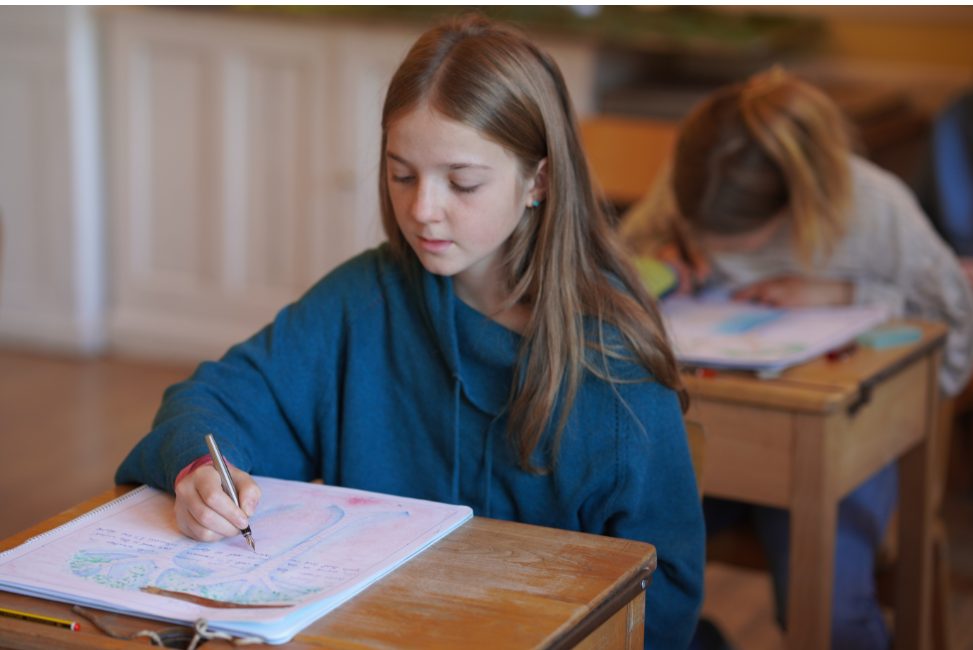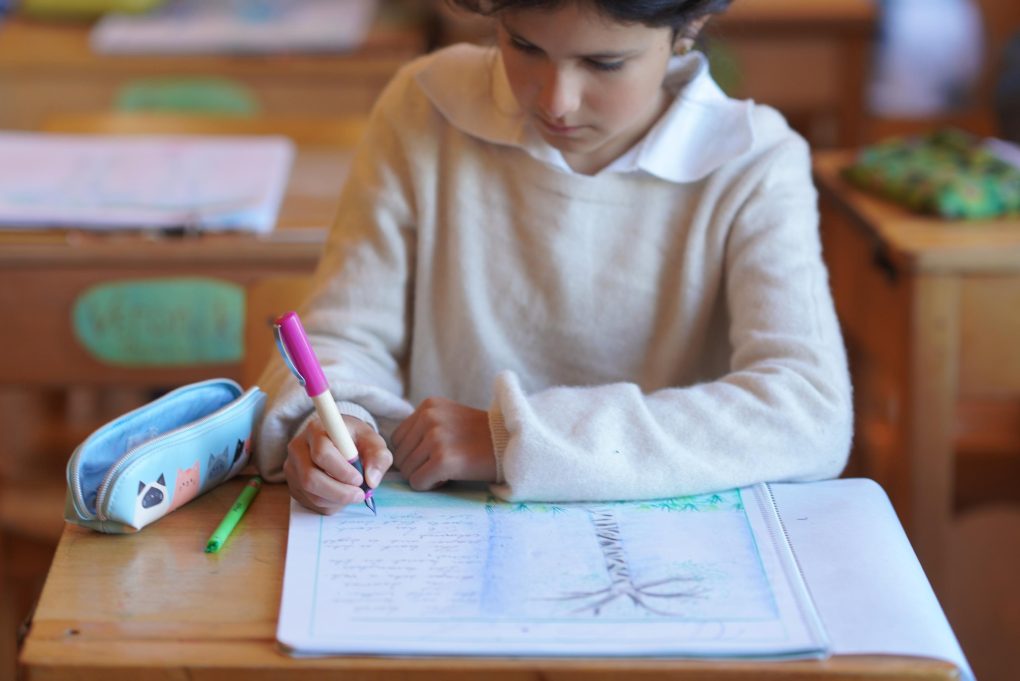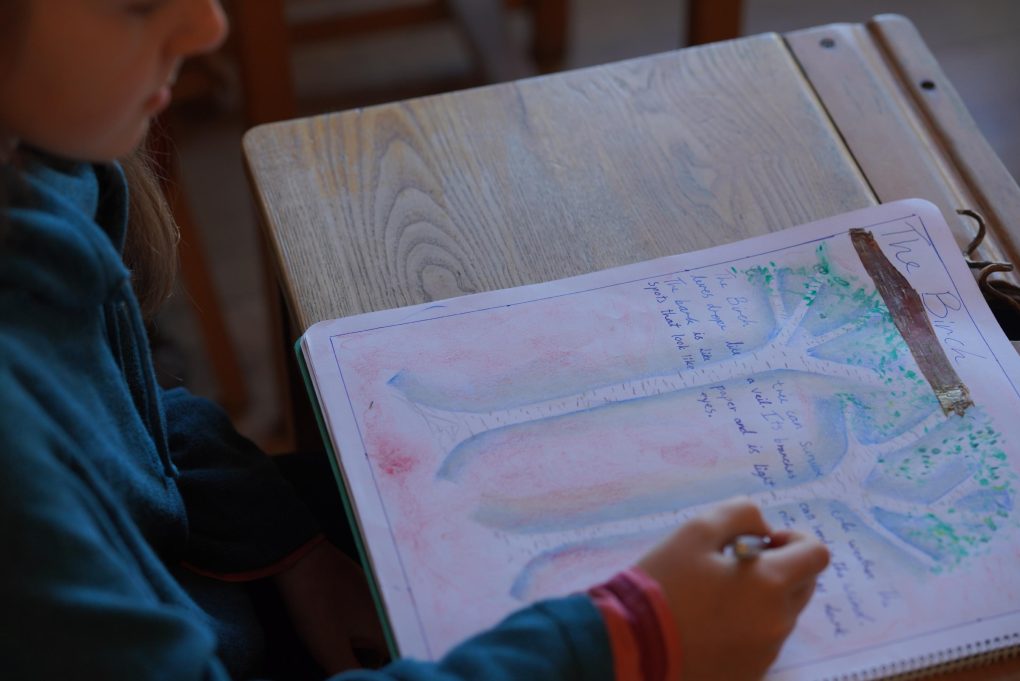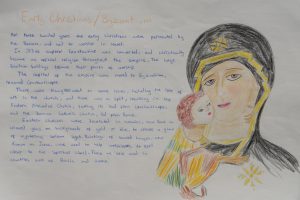Handwriting At Forefront Of Written Word
September 17 2024

Subscribe to our weekly newsletter
Alternatively, receive ESS news in brief through TN Bitesize (WhatsApp Broadcast)
Devices from P1 are now in most schools across Scotland. In a Steiner school, the crayon, giant pencil and fountain pen remain mightier than the touchscreen; with the complex art of handwriting at the forefront of the primary and middle-school years.
Electronic devices are prevalent in education, and many adults – and children – no longer write much by hand. In a Waldorf classroom, educators carefully nurture and develop the skills required for well-formed, accurate and legible handwriting that benefit pupils in ways that can never be replicated by the keyboard, touchscreen or thumb-writing. Our pupils take great pride in the quality of their written work.
Learning to read and write is taken at a fairly slow pace that strives to bring creatively a sense of meaning behind the letters and how they are put together into words and sentences. This is a very different process from that found in mainstream education and ‘first-time’ parents can sometimes feel a little anxious at this gentle pace, if making comparisons with children in other schools who start reading, albeit slowly, from the age of five,”
wrote former ESS teacher, Dorothy Baird’s in her manuscript that ESS has been permitted to publish.
It is helpful to talk to other parents further up the school who have gone through the process themselves and who have watched their child almost magically ‘discover’ how to read, going straight to a book which is quite complex in language and reading fluently. By the age of nine, most children are reading at a level commensurate with or above that of their mainstream peers.” Baird

Pupil works on her Main Lesson book, handwriting with a fountain pen, which is introduced in Class 5.
Writing is introduced in Class 1 following the principle of ‘first do then understand’ – a ‘will’ activity that is developed through regular use – a kind of ‘muscle’, if you will. All reading comes through it.
Distinct from the mainstream approach, very little ‘free writing’ is done by the younger years. Instead, the children write about the stories they have listened to from their Class Teacher. Writing out sentences and even whole verses is essential for learning to read, which at this age are copied from the teacher’s chalkboard. The two go together.
Narrative and storytelling are fundamental elements of Steiner Waldorf education, which recognises the power of imagination to foster creativity and personal growth. “Fairytales are instrumental here in developing in children a strong imagination and healthy moral values. They form the bulk of the Class 1 curriculum as the alphabet and numbers are both introduced through them. Children learn to write the letters of the alphabet and then short excerpts from stories they have heard in class and poems they have learned by heart; they then find they can read what they have written. In this way the two processes go very much hand in hand,” says Baird, illustrating the kinaesthetic activity that activates the brain’s reading systems.
Lowercase cursive script begins in Class 2, prepared by Form Drawing. The pupils strive to orientate themselves on the page of the Main Lesson book and are encouraged to make beautiful shapes with their letters, in their endeavours to make it beautiful. ‘Steiner considered this important since this activity involves the writer more intensely in her work’. He called it ‘drawing writing’, in which the writer ‘pays close attention to his writing’ and ‘develops a somewhat aesthetic relationship with it’ (Source).
Proper handwriting habits are cultivated at this time with the use of Stockmar’s colour giants, fitting easily and securely in the hand, the larger circumference helping to master the fine motor skills of the pencil grip and flow of the letters whilst attention is given to posture; benefitting general cognitive abilities.
In Class 5, the fountain pen is introduced, having first experienced writing with a feather quill. “No keystroke could ever replace a child’s joy at seeing ink being transformed on paper into their very own unique handwriting”, notes Mercurius who manufactures the ergonomically designed fountain pens for Waldorf schools worldwide.
Handwriting is still very much an important art in the older years, cultivated with calligraphy, and practised throughout the school in Main Lesson book work, as well as homework up until Class 8 and beyond in some subjects, playing a fundamental role in helping pupils to retain and recall information.
Edinburgh Steiner School believes that electronic devices should be used appropriately. While devices such as projectors and computers are sometimes a useful aid to teaching, and, when introduced at appropriate ages, can have a beneficial impact on learning, we prefer to minimise the use of screens and digital technology in younger age groups. The use of personal devices in school- by teachers and parents as well as pupils- is also kept to a minimum as far as possible to reduce distraction and to encourage members of the school community to interact in person.

Read the full weekly ezine here: Tuesday Notice
News pieces:
School calendar dates
Management Surgeries
Whole School Meeting Tomorrow
Memorial For Neil Mackay On Friday
Christmas Market Bulletins Each Monday
Christmas Craft Group This Saturday
Michaelmas Bring & Share – All Invited
Summer Term Work Placements Sought For Class 10 Pupils
Updated Parent Handbook Now Available
Published: Qualifications, Exams & Careers (2024/25)
Waldorf Astronaut Is First Commercial Space Walker
Raise Funds For ESS Whilst Shopping
Handwriting At Forefront Of Written Word
Adverts



